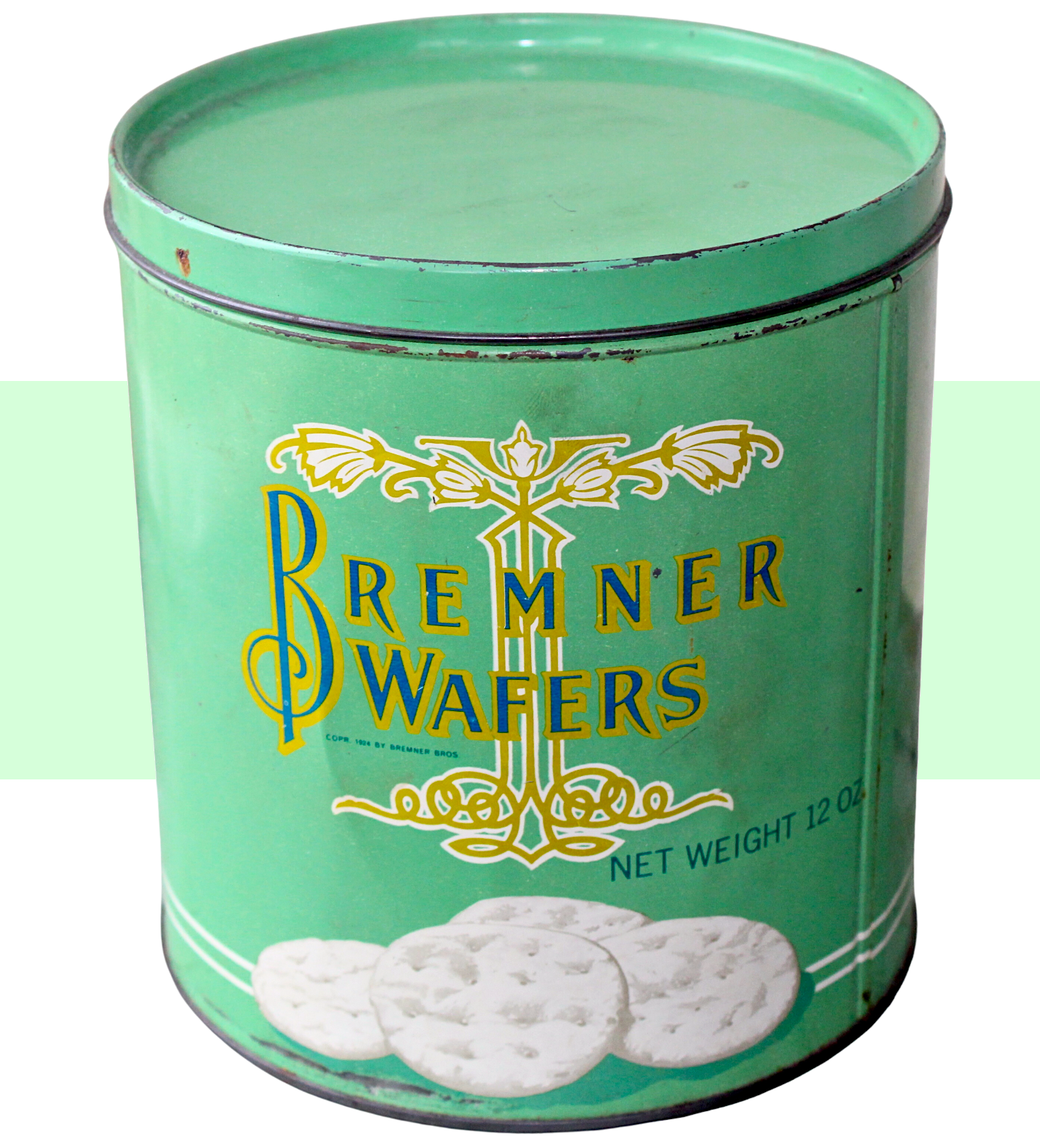
Museum Artifact: Bremner Wafers Tin, 1960s
Made By: Bremner Biscuit Company, 901 W. Arthington St., Chicago, IL [Little Italy / University Village]
The Bremner Biscuit Company was once about as authentically Chicagoan as deep dish pizza and the blues. Unfortunately, the 1980s showed little mercy for such cherished local institutions (even a lot of blues men started recording with synthesized harmonicas), as Bremner abruptly ended its century-long tenure in the city and relocated to Denver—still the company headquarters today.
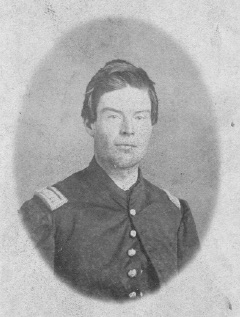
While modern Bremner Wafers might originate in mile-high air, however, the recipe still harks back to the days of David Francis Bremner, a Chicago bread baker who started his business literally as the dust was still settling from the Great Fire of 1871. Rather than seeing a city in ruins, the former Union Army Captain—celebrated for his courage at the Battle of Missionary Ridge—saw an opportunity to serve a devastated public in desperate need of comfort food.
Here was an ad D.F. Bremner placed in the Chicago Tribune way back on March 2, 1873:
Butter Biscuit and Crackers
“The unprecedented sale which Bremner has for his fine crackers, and particularly his butter biscuit, has proven that his confidence in the people of Chicago—that they would support an establishment devoted to the manufacture of fine crackers—was not misplaced. It has also induced others to imitate his goods. To insure the public the genuine article, he has his name stamped on all butter biscuit manufactured in his establishment, and none are genuine without it. Ask your grocer for Bremner’s biscuit, and take no other.”
Those stamped initials, “DFB,” took on a life of their own in Chicago, re-branded as “Damn Fine Bread.” One of David’s secret advantages was fresh milk delivered directly from his father Robert Bremner’s dairy farm in Orland Township. Never underestimate having a supplier on the inside.
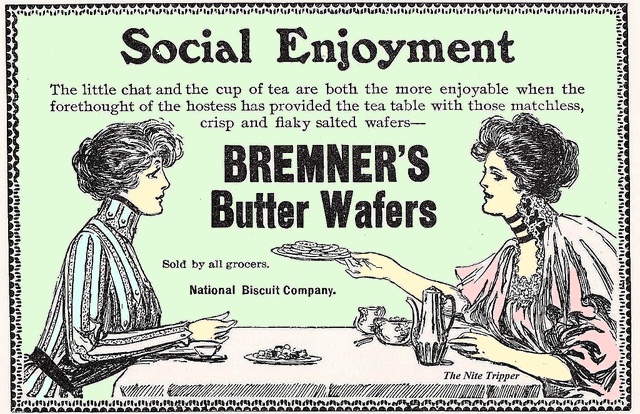
As his notoriety grew, Bremner never lost sight of his original commitment to rebuilding the city, either.
“Mr. Bremner’s activities were many, but he made it a point to take considerable interest in the welfare and up-building of Chicago,” The Cracker Baker magazine recounted years later. “[He] took part in many of the movements after the fire to develop important projects in his adopted city. In recognition for his interest in the civic welfare of Chicago he was appointed a member of the Board of Education, which position he held for several years.”
D.F.B. continue to operate as an independent baker for more than a decade, finally incorporating the D.F. Bremner Baking Company in 1886. Four years later, at the age of 50, he took a much bolder leap, joining a new alliance of leading Midwest bakeries under the banner of the Chicago-based “American Biscuit & Manufacturing Company.” With Bremner serving as Vice President under American Biscuit organizer Adolphus Green, a new golden age had begun.
In 1898, American Biscuit merged its bakery alliance with a couple like-minded conglomerates from the East Coast to form the National Biscuit Company, a little start-up you might know better as NABISCO. It was the ultimate cookie and cracker empire, and Bremner was in the catbird seat as chairman of the manufacturing committee. As he neared retirement age, though, he recognized that his four sons wanted and deserved a greater challenge than merely being a cog in the NABISCO machine.
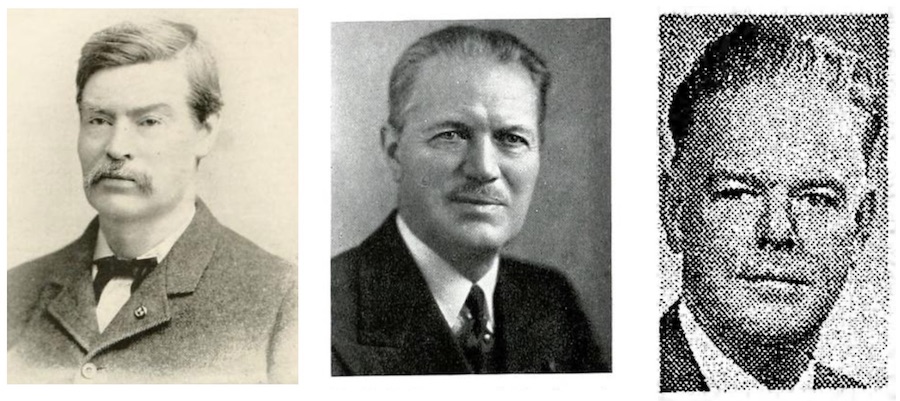 [Three generations of company presidents, from left: D.F. Bremner Sr. (founder, c. 1890s), David F. Bremner Jr. (c. 1920s), Edward G. Bremner (1950s)]
[Three generations of company presidents, from left: D.F. Bremner Sr. (founder, c. 1890s), David F. Bremner Jr. (c. 1920s), Edward G. Bremner (1950s)]
DFB finally called it quits in 1904, and the next generation of Bremners—led by David Jr.—were ready and eager to carry on the family business in their own way. With NABISCO set to move its headquarters to New York, the decision was made to launch a new baking enterprise in Chicago, with Papa Bremner’s blessing. It was called the Bremner Brothers Biscuit Company. The firm was organized in 1905 and quickly picked up where Version 1.0 left off, eventually cementing its legacy by carrying over the wildly popular Bremner Butter Wafer.
Through the 1920s, the Bremner Wafers were sold in silver, rectangular containers, but in the early ‘30s, the company introduced its iconic green tins like the one in our collection. The design largely held form all the way through the 1960s. We can approximate our tin to that later era through a wee bit of deductive reasoning— there is a zip code printed under the Bremner Biscuit Co. name: 60612. Five digit zip codes didn’t come into regular practice until the early 1960s.
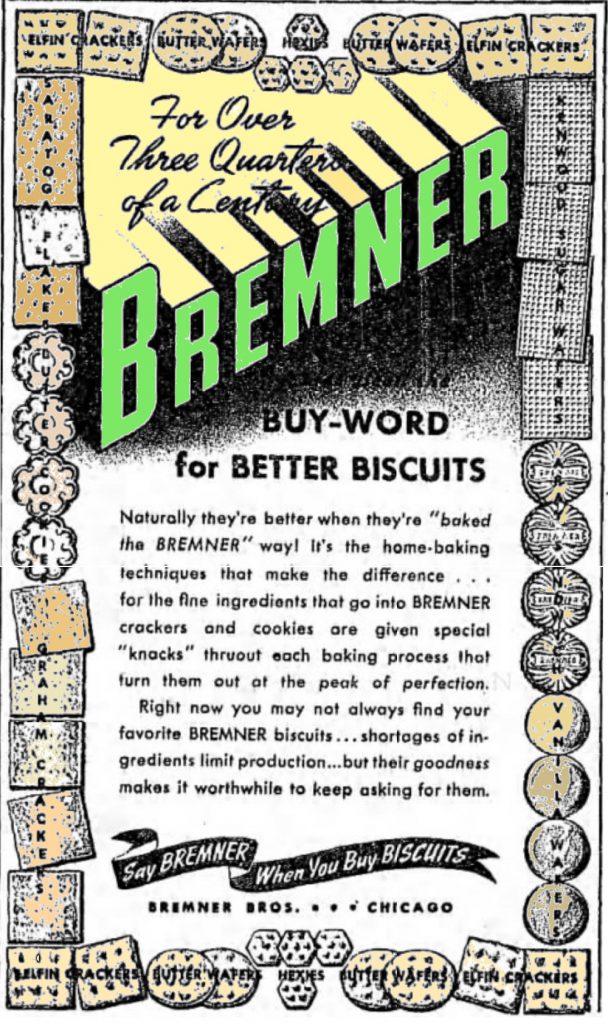 [Bremner Brothers advertisement, 1946]
[Bremner Brothers advertisement, 1946]
Back during the Depression, when the green tin was first introduced, the Bremner factory at 901 W. Forquer Street wound up in the middle of newly sub-divided real estate. Forquer Street was renamed Arthington Street, and from that point on, 901 W. Arthington St. would remain Bremner’s primary Chicago plant. That original building appears to be long gone, replaced with apartment complexes.
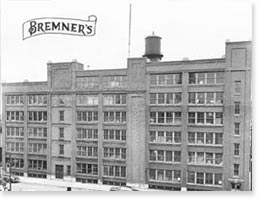 The Arthington Street plant helped keep the encouraging smell of fresh baked wafers floating over the Little Italy neighborhood during World War II. Meanwhile, the Bremner family—led by a third generation in David II’s son Edward—decided it was time to push its substantial wealth beyond the biscuit business.
The Arthington Street plant helped keep the encouraging smell of fresh baked wafers floating over the Little Italy neighborhood during World War II. Meanwhile, the Bremner family—led by a third generation in David II’s son Edward—decided it was time to push its substantial wealth beyond the biscuit business.
Major investments were made in real estate and metal manufacturing, wisely recognizing the boom in both markets. After the war, the Bremners had made a big enough haul from those new ventures (including a lucrative magnesium castings factory downstate) that they were eventually forced to split the company into two wings. The snack operation would now be known as the Bremner Biscuit Company under Edward’s lead, while the Bremner Brothers name would refer exclusively to his brothers’ non-baking pursuits.
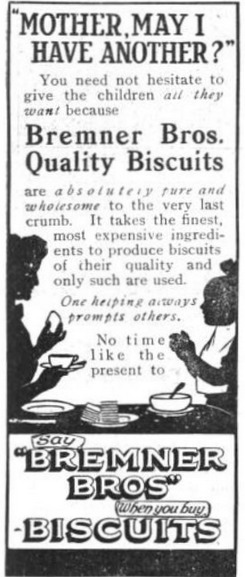 Edward would remain company president through the years of our tin’s creation, finally retiring in 1969. He and his wife Marion would both live well into their 90s, remaining in Winnetka long after the family business moved west. According to his 2003 obituary, Edward traveled the world and learned at least five languages, including Japanese when he was 94 years old.
Edward would remain company president through the years of our tin’s creation, finally retiring in 1969. He and his wife Marion would both live well into their 90s, remaining in Winnetka long after the family business moved west. According to his 2003 obituary, Edward traveled the world and learned at least five languages, including Japanese when he was 94 years old.
“He was an astute businessman who was bright and loved learning,” his grandson Thomas J. Reedy told the Tribune. “[He] was very proud of the business because it is a visible and well-known consumer product that began with his family in 1871 and continues into the present.”
Edward’s son, Edward Bremner, Jr.—generation No. 4—guided the Bremner Biscuit Co. through its centennial celebration and, ultimately, to the Rockies. The family sold the business officially to Dare Foods, Inc. in 1999, although generation No. 5, represented by Neil Bremner, was still involved in managing the Denver baking operation into the 21st century.
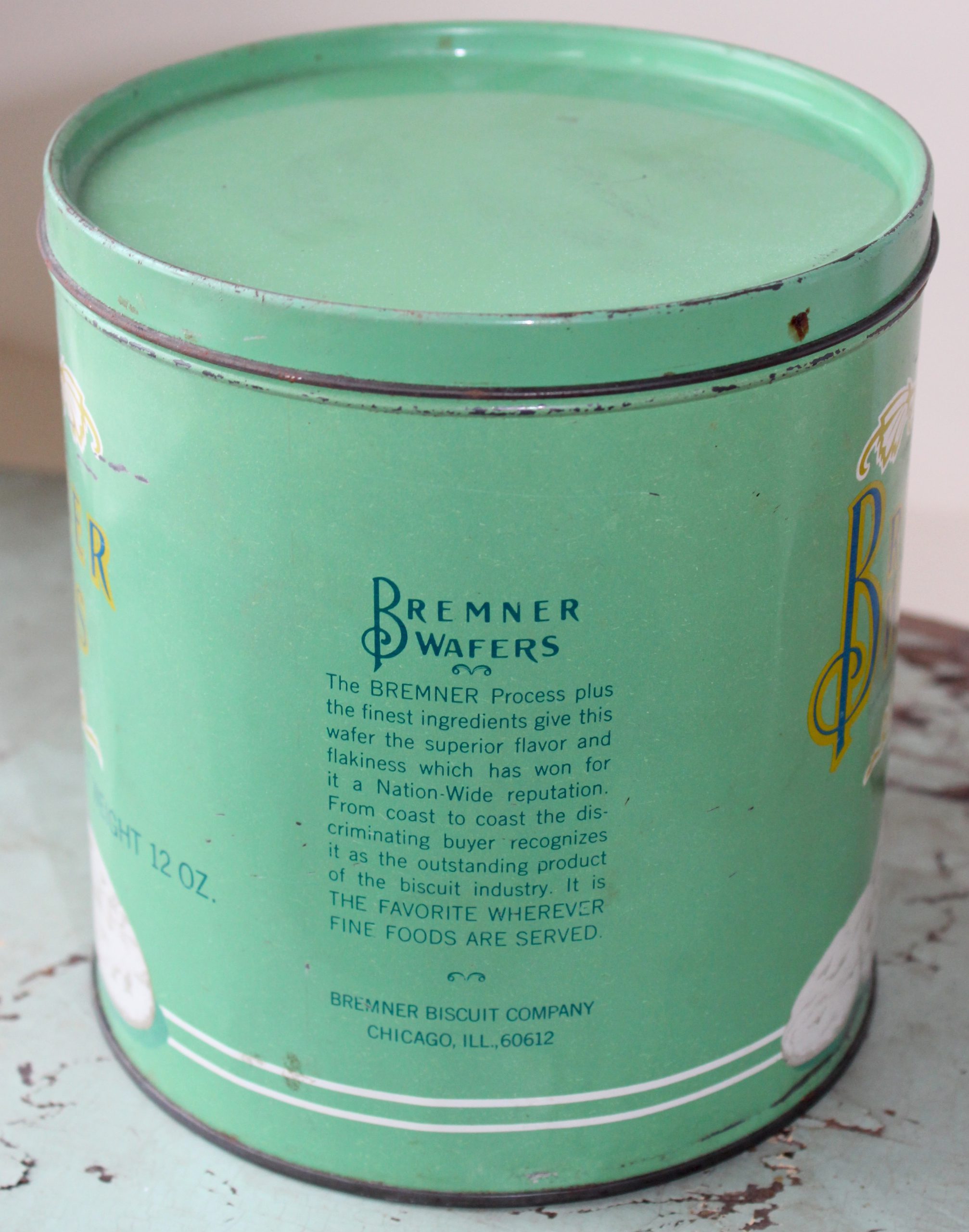
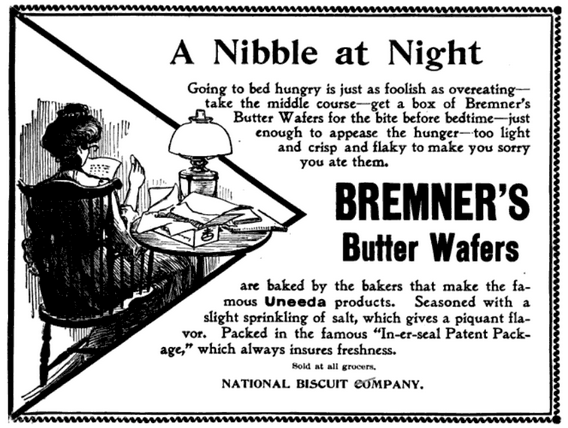
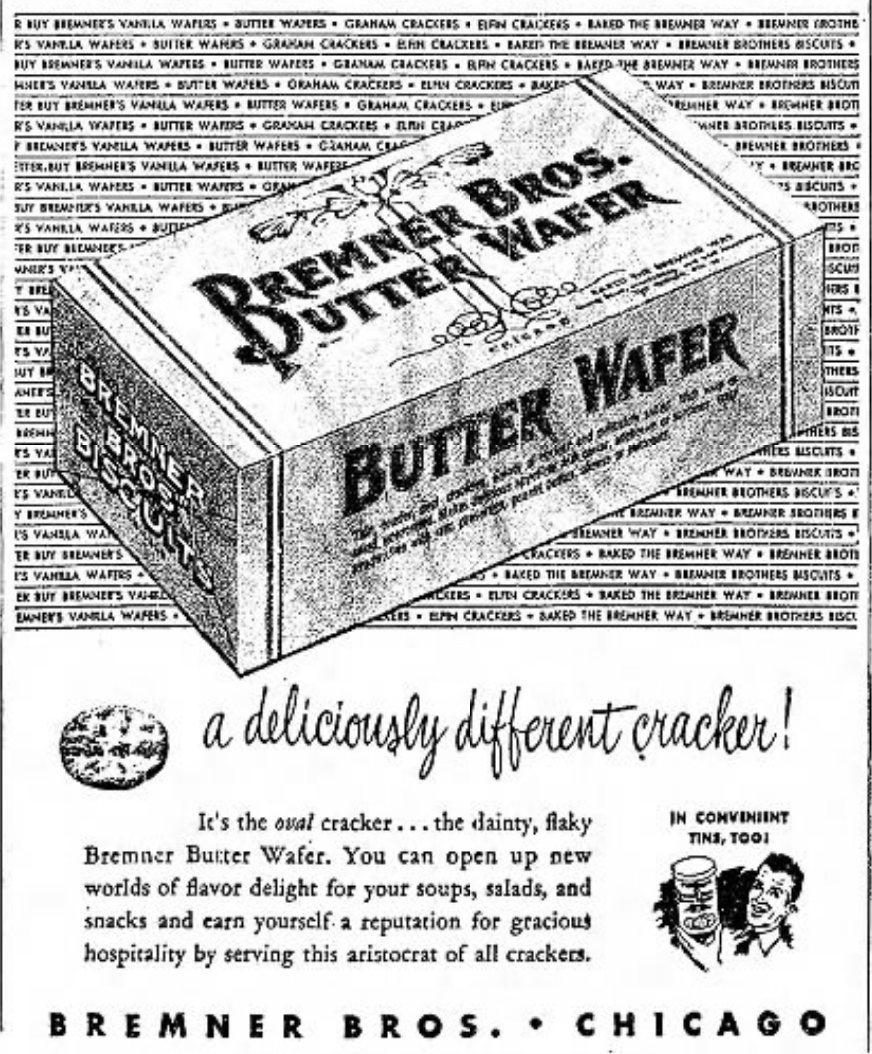
Sources:
The Cracker Baker, June 1922
Chicago and Its Resources Twenty Years After, 1871-1891

Back in 1950-51, while I was in high School, I worked at Bremner.
They also made cookies there , and even made Girl Scout Cookies. As an after school job, several girls from my HS would pack the GS cookies. It was an interesting job.
Does anyone have the recipe for these crackers? Even if the company is gone, it would be great to keep these wafers alive.
My parents bought a 12.5-oz tin of the wafers and never opened it. I’ve just found it. The address listed is 9245 West Cherry St., Franklin Park, IL 60131. Does anyone know when the company was at this address? I’m going to sell it on Ebay at some point. Thanks!
Bremner Wafers were, hands-down, our family’s all-time favorite cracker! Why oh WHY would Dare Foods DISCONTINUE such a magical and delicious-in-the-extreme cherished treat? It makes absolutely no sense whatsoever and millions of fans are devastated.
I’m in possesdion of a sheet metal box that appears to be quite old. Embossed on its hinged lid is:
Bremner Bros.
BrawWafer
CHICAGO
It came into my possession 50+ years ago.
While doing research on Ancestry.com, I came across my great-grandfather’s WWI and WWII draft cards. The 1942 WWII card lists his place of employment as “Bremner Biscuit 901-915 West Arlington Street” (a mistranscription of the Arthington Street address). I called my mom over and she looked at the card and said: “Yes, that’s right, your grandmother always said that when she was a girl her father worked at Bremner’s as a ‘candy-maker’ during the Great Depression and that’s what kept the family fed!” Prior to Bremner’s he was employed by “Sanitary Butter Store” per the WWI draft card, so it makes sense that he transitioned over to Bremner’s. How impressive that this company stayed in business and kept so many people employed during the Great Depression and beyond, including immigrants like my great-grandfather (born in Bohemia, Austro-Hungarian empire).
Loved the information. I love the crackers as well! I’ve been eating them since I was a little girl.
Do you have any Information about Fanny’s Restaurant?
I am new to Chicago area, living in Wheaton, I am looking for Chicago made snack foods I can send to my family in Seattle Washington area – can you please tell me where I may purchase your biscuits? They look delicious. Thank you
Kathy Combs
Hi Kathryn, this is a museum about Chicago industrial history. We are not the Bremner Biscuit Co. Additionally, Bremner biscuits are no longer made in Chicago, so they might not be the best Chicago-made food to send back west.
I am DFBs great, great, great granddaughter. I come from DF jr, and Ed senior and Ed juniors line. I grew up eating these crackers like they were goldfish, in fact they were better then goldfish. Thank you so much for curating this wonderful page full of information!
Hi Holly, I am also a descendent, I would love to compare notes! Bremquest@yahoo.com
Hi there, I am Deidre McEveety. My mother, was Marion Bremner McEveety, born in1926 River Forest IL. Her father was Francis Bremner, from Illinois, born in very late 1800’s. Traced our ancestry back to Keith, Scotland. My mother told me about Bremner Biscuit Company. Thanks for this information. I’m at dmsilbert@gmail.com
That’s where my ancestors comes form too
resending my message; I have the same biscuit tin illustrated above. Have had it for 42+ years and am still using it for my soda crackers. I wonder how many more people have this tin today?
I have had the tin illustrated above for approximately 42 years and am still using it for my soda crackers.